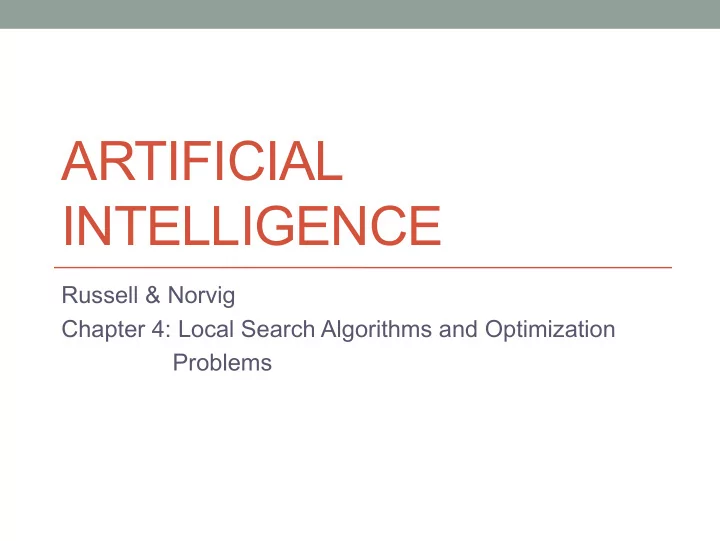

ARTIFICIAL INTELLIGENCE Russell & Norvig Chapter 4: Local Search Algorithms and Optimization Problems
Local search algorithms • Some types of search problems can be formulated in terms of optimization • We don’t have a start state, don’t care about the path to a solution • We have an objective function that tells us about the quality of a possible solution, and we want to find a good solution by minimizing or maximizing the value of this function
Example: n -queens problem • Put n queens on an n × n board with no two queens on the same row, column, or diagonal • State space: all possible n -queen configurations • What’s the objective function ? • Number of pairwise conflicts
Hill-climbing (greedy) search • Idea: keep a single “current” state and try to locally improve it • “Like climbing mount Everest in thick fog with amnesia”
The state space “landscape” • How to escape local maxima (minima)? • Random restart hill-climbing • What about “shoulders”? • What about “plateaus”?
Example: n -queens problem • Put n queens on an n × n board with no two queens on the same row, column, or diagonal • State space: all possible n -queen configurations • Objective function: number of pairwise conflicts • What’s a possible local improvement strategy? • Move one queen within its column to reduce conflicts
Example: n -queens problem (cont’d) h = 17
Hill-climbing (greedy) search • Variants: choose first better successor, randomly choose among better successors • Variants to avoid local maxima, plateaus, shoulders, ridges, etc.
Hill-climbing search • Is it complete/optimal? • No – can get stuck in local optima • Example: local optimum for the 8-queens problem h = 1
Simulated annealing search • Idea: escape local maxima by allowing some "bad" moves but gradually decrease their frequency • Probability of taking downhill move decreases with number of iterations, steepness of downhill move • Controlled by annealing schedule • Inspired by tempering of glass, metal
Simulated annealing search
Simulated annealing search • If temperature decreases slowly enough, then simulated annealing search will find a global optimum with probability approaching one. • However: • This usually takes impractically long • The more downhill steps you need to escape a local optimum, the less likely you are to make all of them in a row
Local beam search Start with k randomly generated states Repeat Generate all the successors of all k states If a goal state is generated, stop Else select the k best successors from the complete list Until some stopping condition • Better than running k greedy searches in parallel. • Stochastic beam search chooses k successors at random, proportional to the “goodness” of the state.
Genetic algorithms (GA) • Variant of stochastic beam search, inspired by “natural selection” • A successor state is generated by combining two parent states • Start with k randomly generated states ( population ) • A state is represented as a string over a finite alphabet (often a string of 0s and 1s) • Evaluation function ( fitness function ). Higher values for better states. • Produce the next generation of states by selection, crossover, and mutation
Genetic algorithms 3 2 7 5 2 4 1 1 2 4 7 4 8 5 5 2 3 2 7 4 8 5 5 2
Genetic algorithms
Recommend
More recommend